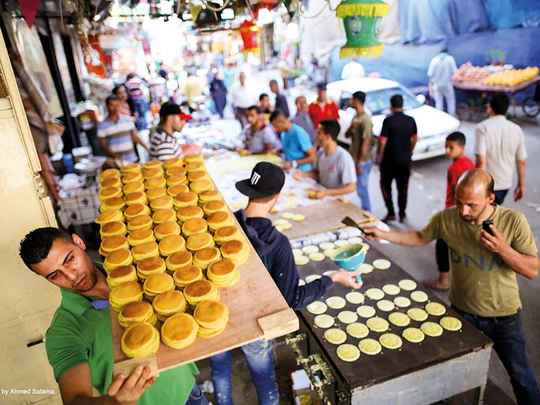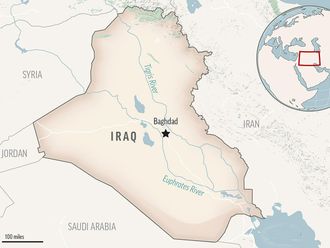
Gaza: Walking down the streets of Gaza you can see families behind their stands, flipping small, perfectly scooped circles of dough over a hotplate with a fire under.
Eyad Shokry Abus Shanab, 39, is one these street vendors who sells Qatayef, a sweet fried dessert.
“My father started this profession 60 years ago, before I was born. He cultivated the recipe over time and taught it to me,” Eyad told Gulf News.
Eyad is a college graduate and has a full-time job, but says he enjoys making the dessert with his brothers during Ramadan to earn some extra money.
Eating Qatayef during Ramadan is considered a sacred tradition by many.
“There is a plate of Qatayef at every table for iftar and suhoor,” he says.
The history of the Qatayef dates back to the Abbasi Caliphate, 566-653 CE. The Calipha or ruler had asked for the sweetest dessert for Ramadan and so the Qatayef came into being.
It has had a special place in the heart’s of Arabs ever since.
Its not easy to make, however, and takes a lot of practice to perfect.
It is made out of fried batter stuffed with a mixture of nuts, yoghurt, white cheese, dates, sugar and cinnamon, then refried in vegetable oil and coated with sugar sauce.
It is eaten by the poor and the rich alike.
Due to the blockade and the shortage of job opportunities, hundreds of Palestinians make Qatayef during the holy month of Ramadan.
Mohammad Ahmad is an Arabic teacher who works for the government and his salary is often delayed or reduced because of political tides.
His wife and four children make Qateyf to earn extra money.
“We work intensely as Eid is ahead of us,” says his son Anas. Anas is an English Literature graduate from Al Zahar University in Gaza City.
“Most people cannot prepare the dessert at home as they don’t have the hotplate and pans needed, nor the recipe,” he explains.
Twenty years ago, when Anas’ father had lost his job with the Palestinian Authority, he began to make Qatayef during Ramadan.
Later, when he found a job teaching Arabic at a local school, Anas and his mother and brothers took over the work.
Anas works the hotplate and his brother makes the rounds calling on customers. Sometimes the father helps with the accounting.
On a good day, Mohammed’s family earns NIS100 ($30; Dh110). But Anas emphasises that as the first two weeks pass, there is a decline in demand.
Despite the hard work, Anas and his little brothers enjoy making Qatayef, as it adds a special flavour to the Ramadan’s atmosphere.












